This is the Tamiya 35 367 kit in 1/35 scale, of the ‘German Heavy Self-Propelled Howitzer Hummel (Late production)’. History The Hummel was developed by German designers in short time, intended to provide a quick boost for troops that had … Continue reading
Tag Archives: howitzer
German DAK 15cm s.IG.33 auf Pz.Kpfw.III (Dragon)
This is the Dragon 6904 kit in 1/35 scale, of the ‘German DAK 15cm s-IG.33 aud Pz.Kpfw.III’.
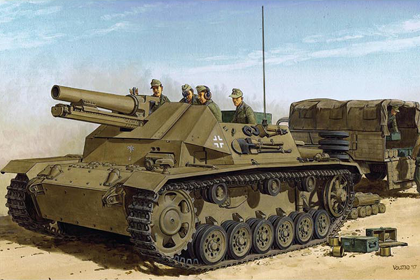
History
It represents a 15cm s.IG.33 auf Fahrgestell Pz.III which, as its name suggests, mated a 15cm field howitzer with a Panzer III chassis.
Field Marshal Erwin Rommel was seeking heavy artillery mounted on tracked chassis because horse-drawn or truck-drawn howitzers were impractical in the desert.
This SPH was used by the Deutsches Afrika Korps, specifically the 90 leichte Infanterie-Division, in North Africa. It first saw action in September 1942.
Manufacturer
Where I got it
- Stoppel Hobby (August 2019)
Russian Project 704 SPH (Trumpeter)
This is the Trumpeter 05575 kit in 1/35 scale, of the ‘Russian Project 704 SPH’.

History
The self-propelled gun carried 20 rounds of two piece (shell and charge) armor-piercing and high explosive ammunition. The secondary armament of the fighting vehicle consisted of two 12.7 x 108mm DShK machine guns, one anti-aircraft and one co-axial.
Manufacturer
Where I got it
- Stoppel Hobby (December 2017)
Russian SU-122, Interior Kit (Initial Production) (MiniArt)
This is the MiniArt 35175 kit in 1/35 scale, of the ‘Russian SU-122 Initial Production, Interior Kit’.
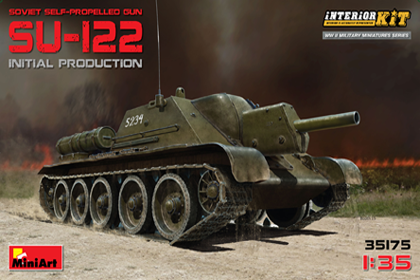
History
The vehicle was based on the T-44 medium tank chassis and was a Russian self-propelled howitzer or assault gun used during World War II.
The machine was designed to destroy fortifications, gun emplacements and tanks.
Manufacturer
German Panzerkampfwagen, KV-2 754(r) (Trumpeter)
This is the Trumpeter 00367 kit in 1/35 scale, of the ‘German Panzerkampfwagen, KV-2 754(r)’.

History
The KV-2 characteristic is its quick-fried tower shape. The quick-fried tower that equip 152 millimeters of howitzers reports the hexagon keeps the square form, resembling an enormous box.
One of the (sturm) Panzerkampfwagen KV-II 754(r) of Panzerkompanie(z.b.v) 66 with the commander’s cupola of a Panzerkampfwagen III G/IV EE and stowage racks for the 152mm ammunition on the rear hull.
Manufacturer
German Sd.Kfz.165 Hummel/Wespe (Dragon)
This is the Dragon 6535 kit in 1/35 scale, of the ‘German Sd.Kfz.165 Hummel/Wespe’.
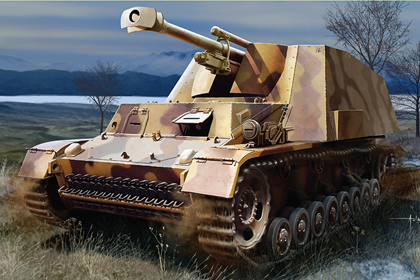
History
The Sd.Kfz.165 Hummel, of which 714 were produced from late 1942 onwards, was created because of an urgent need for artillery that could keep pace with Germany’s panzers during WWII.
Interestingly, the prototype of the Hummel was originally fitted with a 10.5cm leFH18 gun, the weapon that eventually found its way onto the Wespe that was based on the Panzer II chassis.
Manufacturer
Where I got it
- Stoppel Hobby (May 2015)
Russian S-51 Self Propelled Gun (Trumpeter)
This is the Trumpeter 05583 kit in 1/35 scale, of the ‘Russian S-51 Self Propelled Gun’.

History
After November 1943, authorized by the Revolutionary Committee of the Soviet Union the Ge Labin Central Artillery Design Bureau started to design the next generation of self-propelled guns, the KV-1S chassis and B-4 howitzer combination of design, named S-51 self-propelled artillery, optimizeartillery combat combat readiness to complete the 20 minutes.
In addition, due to the strong chassis of the KV-1S tank, the S-51 artillery can be folded to the rear to reduce the bodywork length to facilitate the march. S-51 in early 1944 by nearly 300 design test and a series of wild march test, basically reached the requirements, Soviet firepower summarized as, machine power in artillery belonging to excellent.
Manufacturer
Where I got it
- Stoppel Hobby (July 2014)
German Sd.Kfz.165 Hummel (Late Production) (Dragon)
This is the Dragon 6321 kit in 1/35 scale, of the ‘German Sd.Kfz.165 Hummel – Late Production’.
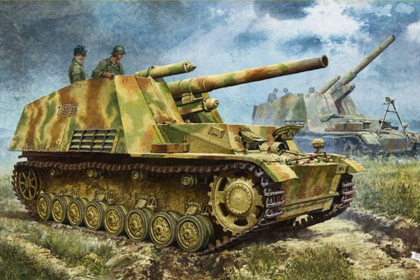
History
The full designation was Panzerfeldhaubitze 18M auf Geschützwagen III/IV (Sf) Hummel, Sd.Kfz.165. On February 27, 1944, Hitler ordered the name Hummel to be dropped as being inappropriate for a fighting vehicle.
Manufacturer
Russian Heavy Self Propelled Gun, SU-152 Howitzer (Trumpeter)
This is the Trumpeter 01571 kit in 1/35 scale, of the ‘Russian Heavy Self propelled, SU-152 Howitzer’.

History
Later production used IS tank chassis and was re-designated as ISU-152. Because of its adopted role of as an impromptu heavy tank destroyer, capable of knocking out the heaviest German armoured vehicles; Tiger, Panther, and Elefant tank destroyers—it was nicknamed Zveroboy, “beast killer”.
Manufacturer
Where I got it
- Stoppel Hobby (December 2013)
Russian Heavy Tank, KV-2 (Trumpeter)
This is the Trumpeter 00312 kit in 1/35 scale, of the Russian Heavy Tank, KV-2′.
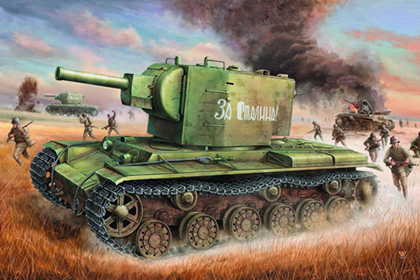
History
The KV-2 characteristic is its quick-fried tower shape. The quick-fried tower that equip 152 millimeters of howitzers reports the hexagon keeps the square form, resembling an enormous box.
But, it is said because of the excess, if not on the horizontal plane, dry by heat the tower connect to revolve all and very difficult. Because of such weakness, KV-2 is in actual battle, only used for proceeding to the virtuous soldier the thermodynamic power inhibit, but need not in the battlefield that hour of backstroke break war.
Manufacturer
Where I got it
- Stoppel Hobby (August 2013)
German 15 cm s.IG.33 (Sf) auf Pz.Kpfw.I Ausf. B (Dragon)
This is the Dragon 6259 kit in 1/35 scale, of the ‘German 15cm s.IG.33 (Sf) auf Pz.Kpfw.I Ausf.B’, sometimes referred to as the Sturmpanzer I Bison.
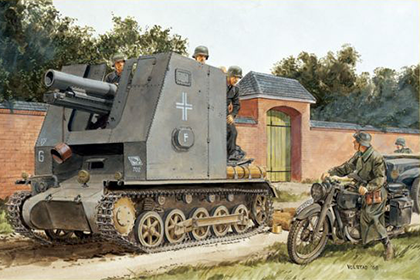
History
It was recognized early on that mobile artillery could provide invaluable fire support to tank units, so the mounting of a 150mm s.IG.33 infantry gun resulted in a vehicle known as an s.IG.33 (Sf) auf Pz.Kpfw.I Ausf.B. The gun was mounted in a tall, boxy superstructure, though the chassis of the Panzer I was overstressed by the extra weight. The armored shield was only 10mm thick and could only offer front and side protection, plus there was no space for spare ammunition to be carried.
Ultimately, this ungainly and top-heavy artillery piece wasn’t a great success and only 38 were converted in February 1940 by Alkett. These guns served in the Battle of France and beyond, though as the war progressed, the 150mm s.IG.33 gun would be mounted on alternative chassis too.
Manufacturer
Where I got it
- Stoppel Hobby (April 2013)
Russian Heavy Tank, KV-2 (Zvezda)
This is the Zvezda 3608 kit in 1/35 scale, of the ‘Russian Heavy Tank, KV-2’.
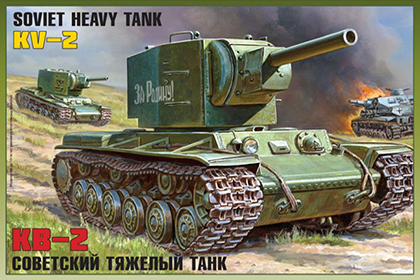
History
The production of the KV-2s started in 1940 and soon after the start of WWII in Russia the production of the vehicles was phased out as this single-purpose tank was an exorbitant luxury in the severe conditions of the initial period of the war.